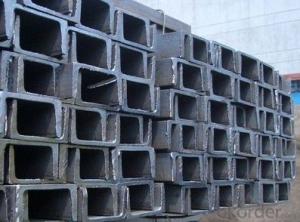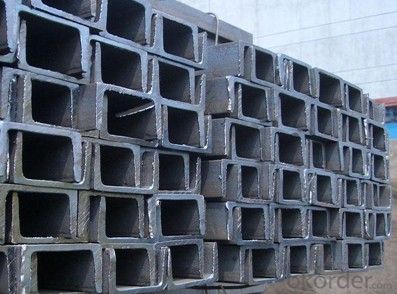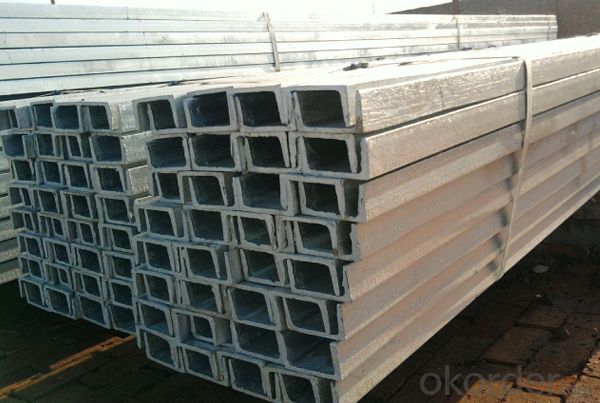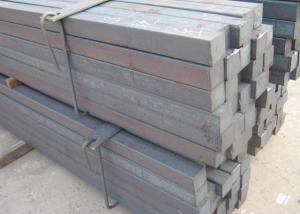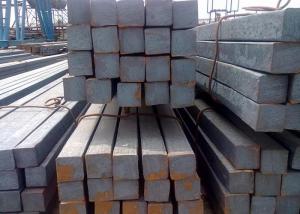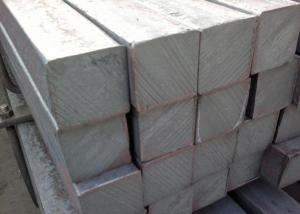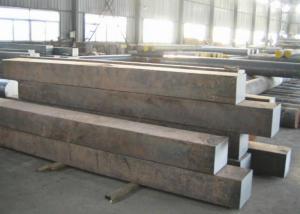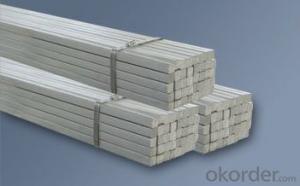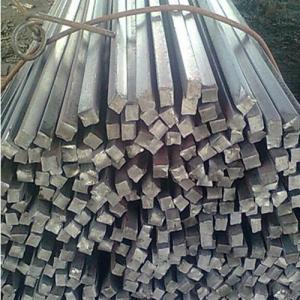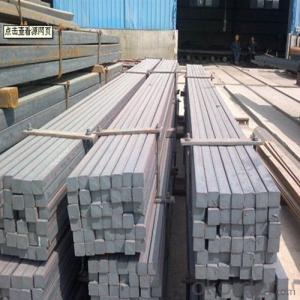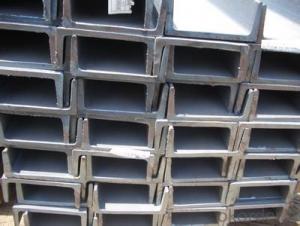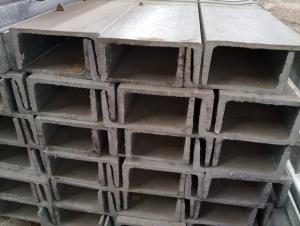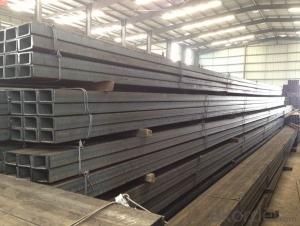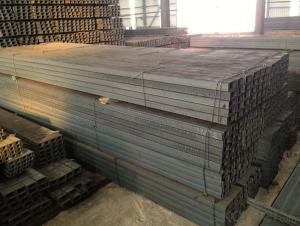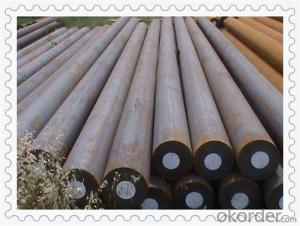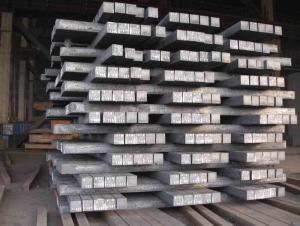Steel U Channel GB Q235 JIS G3192 Hot Rolled High Quality
- Loading Port:
- Tianjin
- Payment Terms:
- TT or LC
- Min Order Qty:
- 25 m.t.
- Supply Capability:
- 2000000 m.t./month
OKorder Service Pledge
OKorder Financial Service
You Might Also Like
Product Description:
OKorder is offering Steel U Channel GB Q235 JIS G3192 Hot Rolled High Quality at great prices with worldwide shipping. Our supplier is a world-class manufacturer of steel, with our products utilized the world over. OKorder annually supplies products to European, North American and Asian markets. We provide quotations within 24 hours of receiving an inquiry and guarantee competitive prices.
Product Applications:
According to the needs of different structures, Angle can compose to different force support component, and also can be the connections between components. It is widely used in various building structures and engineering structures such as roof beams, bridges, transmission towers, hoisting machinery and transport machinery, ships, industrial furnaces, reaction tower, container frame and warehouse etc
Product Advantages:
OKorder's Steel U Channel GB Q235 JIS G3192 Hot Rolled High Quality are durable, strong, and resist corrosion.
Main Product Features:
· Premium quality
· Prompt delivery & seaworthy packing (30 days after receiving deposit)
· Corrosion resistance
· Can be recycled and reused
· Mill test certification
· Professional Service
· Competitive pricing
Product Specifications:
Manufacture: Hot rolled
Grade: Q195 – 235
Certificates: ISO, SGS, BV, CIQ
Length: 6m – 12m, as per customer request
Packaging: Export packing, nude packing, bundled
Sizes: 25mm-250mm | ||||||||||||
a*t | ||||||||||||
25*2.5-4.0 | 70*6.0-9.0 | 130*9.0-15 | ||||||||||
30*2.5-6.6 | 75*6.0-9.0 | 140*10-14 | ||||||||||
36*3.0-5.0 | 80*5.0-10 | 150*10-20 | ||||||||||
38*2.3-6.0 | 90*7.0-10 | 160*10-16 | ||||||||||
40*3.0-5.0 | 100*6.0-12 | 175*12-15 | ||||||||||
45*4.0-6.0 | 110*8.0-10 | 180*12-18 | ||||||||||
50*4.0-6.0 | 120*6.0-15 | 200*14-25 | ||||||||||
60*4.0-8.0 | 125*8.0-14 | 250*25 | ||||||||||
FAQ:
Q1: Why buy Materials & Equipment from OKorder.com?
A1: All products offered byOKorder.com are carefully selected from China's most reliable manufacturing enterprises. Through its ISO certifications, OKorder.com adheres to the highest standards and a commitment to supply chain safety and customer satisfaction.
Q2: How do we guarantee the quality of our products?
A2: We have established an advanced quality management system which conducts strict quality tests at every step, from raw materials to the final product. At the same time, we provide extensive follow-up service assurances as required.
Q3: How soon can we receive the product after purchase?
A3: Within three days of placing an order, we will begin production. The specific shipping date is dependent upon international and government factors, but is typically 7 to 10 workdays.
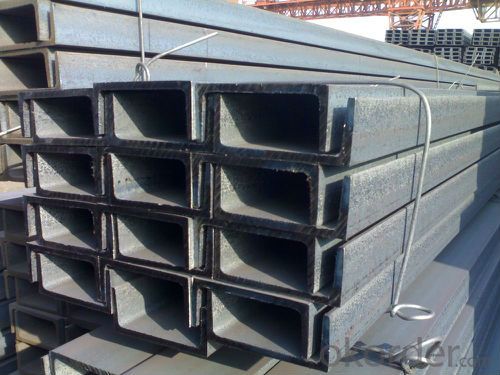

- Q: What are the common mistakes to avoid when using a steel square?
- When using a steel square, there are several common mistakes that should be avoided to ensure accurate measurements and precise angles: 1. Misalignment: One of the most common mistakes is not properly aligning the steel square with the workpiece. It is essential to ensure that the square is perfectly parallel to the edges or surfaces being measured. Any misalignment can lead to inaccurate measurements and flawed angles. 2. Inconsistent pressure: Applying inconsistent pressure while marking or cutting can result in variations in the measurements. It is crucial to maintain a steady and consistent pressure while using a steel square to ensure accuracy. 3. Ignoring squareness: Over time, steel squares can lose their squareness due to wear and tear. It is important to regularly check the squareness of the tool and make any necessary adjustments or replacements. Ignoring squareness can lead to skewed measurements and inaccurate angles. 4. Incorrect positioning: Placing the steel square in the wrong position can also lead to errors. It is essential to position the square firmly against the edges or surfaces being measured to obtain accurate readings. Improper positioning can result in imprecise measurements and angles. 5. Neglecting cleanliness: Accumulated dirt, dust, or debris on the steel square can interfere with accurate measurements. Regularly clean the square to ensure smooth movements and precise readings. By avoiding these common mistakes, users can effectively utilize a steel square for measuring, marking, and cutting tasks, ensuring precise angles and accurate measurements.
- Q: Can a steel square be used for checking the plumbness of a post hole?
- Indeed, a post hole's plumbness can be assessed using a steel square. A highly versatile tool, the steel square is widely employed in woodworking and construction activities. It boasts a right angle of 90 degrees, which can be aligned with the post hole's sides to gauge its plumbness. By placing the steel square against the hole's walls, one can ascertain if they are truly vertical and without any curvature. Should the steel square fail to align correctly, adjustments can be made to guarantee the post's plumb position. However, it is worth noting that while a steel square can aid in an initial check, a more precise measurement can be achieved by using a plumb bob or a level to ensure the post is perfectly vertical.
- Q: Can a steel square be used for checking the flatness of a ceiling?
- No, a steel square cannot be used for checking the flatness of a ceiling. A steel square is primarily used in woodworking and metalworking to measure and mark right angles. It is not designed or suitable for checking the flatness of large surfaces such as ceilings. For checking the flatness of a ceiling, other tools like a straightedge or a laser level would be more appropriate.
- Q: How is a steel square different from a combination square?
- A steel square is a measuring tool that consists of a ruler and a right angle, commonly used in carpentry and woodworking. It is primarily used for measuring and marking right angles. On the other hand, a combination square is a versatile tool that includes a ruler, right angle, and a sliding head. It can be used for measuring and marking angles, depths, and distances, making it more versatile and multipurpose compared to a steel square. In summary, while a steel square is specifically designed for measuring right angles, a combination square offers additional features and functionalities, making it a more flexible tool for various measuring and marking tasks.
- Q: How do you use a steel square to measure board lengths at different points?
- To measure board lengths at different points with a steel square, follow these instructions: 1. Align one edge of the steel square with the end of the board you wish to measure, ensuring it is flush against the board's edge. 2. Firmly hold the steel square in place with one hand, ensuring it remains stationary throughout the measurement process. 3. Examine the measurements indicated on the blade of the steel square. These markings typically represent inches (or centimeters) and are usually labeled from 1 to 24 or more. 4. Glide the steel square along the board's length while maintaining a straight and aligned position with the edge. Take note of the measurement at the desired point to determine the board's length. 5. When you reach the desired measurement point, refer to the corresponding number on the blade of the steel square. This number signifies the length of the board from the starting point to the current position. 6. If you need to measure another point on the same board, repeat steps 1 to 5, ensuring the steel square remains aligned with the board's edge. Using a steel square to measure board lengths at various points is a simple process that relies on the accuracy and precision of the square's markings. By following these instructions, you can acquire precise measurements for your woodworking or construction projects.
- Q: How does a steel square help in determining roof pitches?
- Carpenters and roofers rely on a versatile tool known as a steel square, also called a framing square or carpenter's square, for a variety of measurements and calculations. When it comes to determining roof pitches, this tool proves to be extremely helpful. The steel square possesses a key feature, its ability to measure and lay out angles. Comprising two arms, a longer one called the blade and a shorter one called the tongue, it forms a 90-degree angle. Along the edges of the blade and tongue, there are markings and measurements that aid in determining roof pitches. To determine the pitch of a roof using a steel square, one must first place the tool on the roof surface. The blade aligns parallel to the roof ridge, while the tongue aligns with the roof slope. By adjusting the square and observing where the tongue meets the roof, one can easily determine the pitch of the roof. In terms of accuracy, the steel square offers a range of measurements and angles to calculate various roof pitches. The blade of the square contains rafter tables that provide essential information for determining the length and angle of the roof rafters. By aligning the appropriate measurements and angles on the square with the desired pitch, roofers can effortlessly determine the necessary cuts and angles for the roof rafters. Moreover, the steel square serves another purpose in measuring and marking the pitch on other roofing materials like shingles or tiles. By aligning the square with the desired pitch, one can effortlessly transfer the measurements onto the roofing material, ensuring precise installation. All in all, the steel square proves to be an indispensable tool for determining roof pitches. With its accurate measurements, angles, and markings, it provides carpenters and roofers with the necessary means to carry out precise calculations and efficient roof installations.
- Q: Glass partition, square box outsourcing 1mm thick stainless steel, glass middle is how to set the quota
- In this case, a metal frame must be used to hold the glass and then bolt it into the wall!
- Q: How do you use a steel square to determine the length of a handrail?
- To determine the length of a handrail using a steel square, follow these steps: 1. Start by checking that the steel square is clean and clear of any debris or rust that could impact the accuracy of your measurements. 2. Place the steel square against one end of the handrail, ensuring it is flush with the end. 3. Move the steel square along the handrail's length until it reaches the other end, making sure it remains flush against the handrail throughout. 4. Once the square is aligned with the handrail's other end, take note of the measurement shown on the square. This measurement represents the handrail's length. 5. Remember that steel squares usually have measurements on both the inside and outside edges. Be sure to refer to the appropriate measurement line based on your specific requirements. 6. If you are dealing with a handrail that has multiple sections or curves, repeat the above steps for each section. For curved handrails, additional measurements along the curve may be necessary to ensure accuracy. Using a steel square to determine the length of a handrail is a straightforward and efficient method, providing precise measurements for construction or renovation projects.
- Q: How do you use a steel square to determine the width of a board?
- To use a steel square to determine the width of a board, there are a few simple steps to follow. First, ensure that the steel square is clean and free from any debris or rust. This will help ensure accurate measurements. Next, place the steel square against one side of the board, aligning it so that one edge of the square is flush against the edge of the board. Hold the square firmly in place and look at the markings on the square. The steel square typically has measurements marked in inches on one side and in centimeters on the other side. Find the marking on the square that corresponds to the width you are trying to determine. For example, if you want to find the width of the board in inches, locate the appropriate inch marking on the square. Once you have located the correct marking, look at the opposite side of the square where it meets the other edge of the board. This point will indicate the width of the board. Take note of the measurement and record it if necessary. Repeat this process on different sections of the board to ensure accuracy, as boards can sometimes have slight variations in width. By using a steel square in this way, you can easily determine the width of a board with precision and accuracy.
- Q: How do you determine the thickness of a steel square?
- There are several methods available for determining the thickness of a steel square. One commonly used approach involves utilizing a caliper, a specialized tool designed for measuring thickness. To employ this method, insert the square between the jaws of the caliper and gently close them until they make contact with both sides of the square. The measurement displayed on the caliper will indicate the thickness of the steel square. Alternatively, a more precise method involves employing a micrometer, which is a tool specifically designed for measuring thickness. Similar to the caliper, place the square between the jaws of the micrometer and tighten them until they securely grasp the square. The measurement displayed on the micrometer will provide an accurate reading of the steel square's thickness. If access to specialized measuring tools is not available, a ruler or tape measure can be utilized. However, it must be kept in mind that these tools may not offer the same level of accuracy. Place the square on a flat surface and use the ruler or tape measure to determine the distance between one side and the other. This measurement will yield an approximation of the steel square's thickness. It is important to emphasize that when utilizing any measuring tool, it is crucial to handle the square with care and ensure that it is properly aligned and flat on the measuring surface. Additionally, always verify the measurement to ensure accuracy.
Send your message to us
Steel U Channel GB Q235 JIS G3192 Hot Rolled High Quality
- Loading Port:
- Tianjin
- Payment Terms:
- TT or LC
- Min Order Qty:
- 25 m.t.
- Supply Capability:
- 2000000 m.t./month
OKorder Service Pledge
OKorder Financial Service
Similar products
Hot products
Hot Searches
Related keywords
